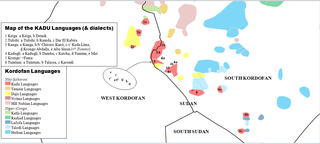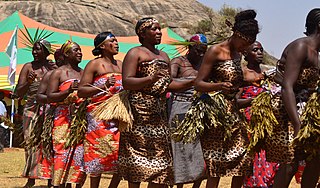
The Afroasiatic languages, also known as Hamito-Semitic or Semito-Hamitic, are a language family of about 400 languages spoken predominantly in West Asia, North Africa, the Horn of Africa, and parts of the Sahara and Sahel. Over 500 million people are native speakers of an Afroasiatic language, constituting the fourth-largest language family after Indo-European, Sino-Tibetan, and Niger–Congo. Most linguists divide the family into six branches: Berber, Chadic, Cushitic, Egyptian, Semitic, and Omotic. The vast majority of Afroasiatic languages are considered indigenous to the African continent, including all those not belonging to the Semitic branch.
The Omotic languages are a group of languages spoken in southwestern Ethiopia, in the Omo River region and southeastern Sudan in Blue Nile State. The Geʽez script is used to write some of the Omotic languages, the Latin script for some others. They are fairly agglutinative and have complex tonal systems. The languages have around 7.9 million speakers. The group is generally classified as belonging to the Afroasiatic language family, but this is disputed by some linguists.
Bussa, or Mossiya, is a Cushitic language spoken in the Dirashe special woreda of the Southern Nations, Nationalities, and People's Region located in southern Ethiopia. The people themselves, numbering 18,000 according to the 2007 census, call their language Mossittaata.

The Kadu languages, also known as Kadugli–Krongo or Tumtum, are a small language family of the Kordofanian geographic grouping, once included in Niger–Congo. However, since Thilo Schadeberg (1981), Kadu is widely seen as Nilo-Saharan. Evidence for a Niger-Congo affiliation is rejected, and a Nilo-Saharan relationship is controversial. A conservative classification would treat the Kadu languages as an independent family.
The Ometo languages of Ethiopia are a dialect cluster of the Omotic family, generally accepted as part of the Afro-Asiatic language family. They include the most populous Omotic language, Wolaytta, with two million speakers. The languages have around 4 million speakers.

The West Chadic languages of the Afro-Asiatic family are spoken principally in Niger and Nigeria. They include Hausa, the most populous Chadic language and a major language of West Africa.
Koenoem is an Afro-Asiatic language spoken in Plateau State, Nigeria. It is spoken in about 6 villages east of the Panyam-Shendam road.
Montol is an Afroasiatic language spoken in Plateau State, Nigeria. Dialects are Baltap-Lalin and Montol. Roger Blench (2017) uses the name Tel or Tɛɛl for Montol.
Pyapun is an Afro-Asiatic language spoken in Plateau State, Nigeria. It is spoken in about 10 villages east of the Panyam-Shendam road.
Tal is an Afro-Asiatic language spoken in Plateau State, Nigeria. Tal is spoken in a cluster of 53 villages located east of the Panyam-Shendam road. There are 6 dialects of Tal, namely Bongmuut, Buzuk, Nbaal, Muɗak, Muɗong, and Takong.
Psikye is an Afro-Asiatic language spoken in northern Cameroon and eastern Nigeria. Varieties include Psikyɛ and Zləngə. Blench (2006) classifies it as a dialect of Kamwe.
Cineni is an Afro-Asiatic language spoken in Borno State, Nigeria in the single village of Cineni. In a 2006 paper, Roger Blench classified it as a dialect of Guduf-Gava.
Guduf-Gava is an Afro-Asiatic language spoken in Borno State, Nigeria. In a 2006 paper, Roger Blench classified Cineni as a dialect.

Ron is an Afro-Asiatic language cluster spoken in Plateau State, Nigeria. Dialects include Bokkos, Daffo-Mbar-Butura, Monguna/Manguna (Shagau),. Blench (2006) considers these to be separate languages.
Jimi is an Afro-Asiatic language spoken in Jimi village in Bauchi State, Nigeria. Blench (2006) considers the Zumo (Jum) variety to be a separate language.
Ale is an Afro-Asiatic language spoken in southern Ethiopia in the administratively part of the "South Ethiopia Regional State" (SERS). It is part of the Dullay dialect cluster.
Tumak, also known as Toumak, Tumag, Tummok, Sara Toumak, Tumac, and Dije, is an Afro-Asiatic language spoken in the southwestern Chadian prefectures of Moyen-Chari and Koumra. Motun (Mod) and Tumak dialects have a lexical similarity of only 70%; Blench (2006) lists Tumak, Motun, and Mawer as separate languages. Most Motun speakers use some Sara.
Lamang (Laamang) is an Afro-Asiatic language cluster of Nigeria. Blench (2006) classifies the Woga variety as a separate language.
Vemgo-Mabas is an Afro-Asiatic language of Cameroon and Nigeria. Dialects are Vemgo, Mabas. Blench (2006) considers these to be separate languages. Ethnologue lists a third dialect, Visik in Nigeria, which is not well attested; Blench suspects it may be a dialect of Lamang instead.
Dobase is a Cushitic language spoken in the Dirashe special woreda of the Southern Nations, Nationalities, and People's Region located in southern Ethiopia. When Blench (2006) reclassified Bussa from the Dullay to the Konsoid branch of Cushitic, he left the erstwhile Mashole, Lohu, and Dobase dialects behind as the Dobase language.



